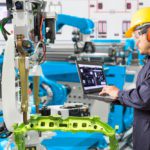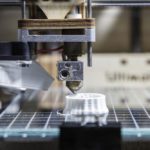Smart Factory Team
3 Low Volume Manufacturing Methods
Companies use a low-volume approach to test products in the market before high volume production or if the demand is small. Low volume options include injection molding, CNC milling, and…
Read MoreAdvantages of 3D Printing in High-Volume Contract Manufacturing
Contract manufacturing services bring new low or high-volume products to market quickly without requiring large capital equipment expenditures. They lower the barriers for high-volume production as companies do not need to set up factories to manufacture products. Innovations in 3D printing have made it possible to support high-volume production at localized cloud-connected 3D printing smart factories. Utilizing a 3D printing solution for high-volume contract manufacturing helps companies stay agile, produce more complex designs, support multiple SKUs, and manufacture products with advanced high-performance materials.
Read MoreFour Applications of Rapid Prototyping with 3D Printing
3D printing has many rapid prototyping applications, allowing companies to accomplish more in less time without sacrificing product quality. Today’s 3D printing systems require no tooling and support a broad range of materials, so designers can enable rapid functional prototyping and make faster transitions to full-scale manufacturing.
Read MoreGuide to the Ideal Additive Manufacturing Process
Additive manufacturing is often associated with low-volume production or prototyping. Some 3D printers are developed for the sole purpose of rapid prototyping. Still, innovations in 3D printing technology have made high-volume production both feasible and often the best solution for accelerating a new product to market. 3D printing has no tooling costs and very few design limitations. Companies can implement 3D printing solutions from innovation through production, eliminating certain drawbacks associated with traditional manufacturing.
Read MoreWhat is 3D Printing, Additive Manufacturing, and Rapid Prototyping?
Dentists, aerospace engineers, footwear manufacturers, and other industries utilize 3D solutions to streamline production processes, expand design possibilities, create better-performing products, and enable a more resilient supply chain.
Read MoreFrom Design or Prototyping to High Volume Manufacturing and Automation With Connected 3D Printing
3D printing is allowing companies to improve manufacturing capabilities, whether in-house or leveraging contract 3D printing services in a smart factory. Companies in many industries can see multiple benefits when they use 3D printing smart factories for high volume or low volume/high mix manufacturing. Here’s how companies can accelerate the go-to-market of new products from prototyping to high volume manufacturing.
Read MoreHow to Scale Up Manufacturing With a Smart Factory
With flexibility and a high level of automation, 3D printing helps manufacturers accelerate new product introduction (NPI) and full-scale production. Commercialization of 3D printing systems in smart factories has also brought costs down, allowing more companies to take advantage of additive manufacturing services. When deciding how to scale up manufacturing of new or existing products, partnering with a smart factory leveraging 3D printing allows greater flexibility in manufacturing capacity, while accelerating production ramp-up and supporting a high mix-low volume suite of products.
Read More4 Low Volume Manufacturing Strategies Leveraging 3D Printing to Reduce Cost and Risk
3D printing systems eliminate the need for tooling which decreases upfront costs, reduces the inventory on hand requirement, speeds up design to production cycles, and enables a more diverse set of products manufactured at any one site. The flexibility and agility allow companies to easily implement low volume manufacturing strategies that can make them more competitive.
Read MoreHow 3D Printing Is Changing the Manufacturing Industry by Enabling Flexible Supply Chains
With 3D printing, the tooling costs to manufacture new and modified products and designs are eliminated. With no tooling and greater flexibility, 3D printing reduces the cost structure and risk, and changes the business model for manufacturers. 3D printing is changing the manufacturing industry and offers several advantages that enable agility.
Read More- « Previous
- 1
- 2
- 3









